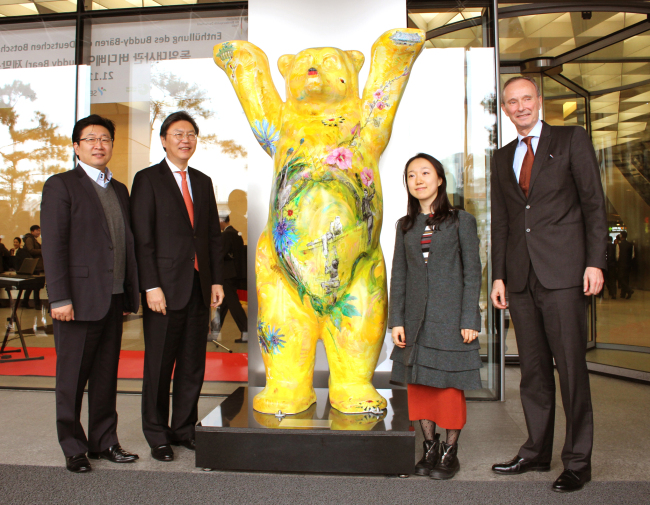The Buddy Bear -- Berlin’s symbolic mascot epitomizing the once-divided city’s prospering unity, peace and openness -- was replicated in Seoul last week through municipal and diplomatic collaboration.
The sculpture, standing 2 meters tall and decorated in bright yellow, was unveiled Nov. 21 in front of the Seoul Square building, where the German Embassy and many German companies are located.
A token of Teutonic tolerance toward the world, the statue has been installed in front of numerous German diplomatic missions worldwide.
The creator of the winning model in Seoul was Jang Yoon-hee, who majors in Western painting at Seoul National University. She won the design competition as judged by a panel of experts from the embassy, Seoul Square, Goethe-Institut Korea and Seoul National University.
The sculpture, standing 2 meters tall and decorated in bright yellow, was unveiled Nov. 21 in front of the Seoul Square building, where the German Embassy and many German companies are located.
A token of Teutonic tolerance toward the world, the statue has been installed in front of numerous German diplomatic missions worldwide.
The creator of the winning model in Seoul was Jang Yoon-hee, who majors in Western painting at Seoul National University. She won the design competition as judged by a panel of experts from the embassy, Seoul Square, Goethe-Institut Korea and Seoul National University.

“The bear has represented Berlin for hundreds of years,” said German Ambassador to Korea Stephan Auer in a speech. “Berlin during the Cold War was carved along the Berlin Wall and deathly barbed wire fences. As a crucible of history, the city coagulated pains emanating from dictatorship and division.”
As the Berlin Wall crumbled and Cold War borders dissolved, the new German capital’s visage changed, the envoy said, adding it became a city of hope and solidarity.
The Buddy Bear, bearing the animal’s real-life proportions, was first designed and designated across the city in 2001. It soon became a magnet for tourists, permeating the streets with energy and elegance that spread beyond the municipal boundaries.
“Buddy Bears came to symbolize peaceful coexistence and cooperation between countries,” Auer said.
In 2002, a United Buddy Bear project involving international artists was launched. They produced 125 models that were showcased round the world. The figures came to Korea in 2005 and were displayed at the Seoul Olympic Park.
Kim’s work portrays Germany’s national flower knapweed and Korea’s hibiscus, emblematic edifices of the two countries and the Berlin Wall. The ambassador lauded the sculpture, saying it harmonizes the German and Korean identities and embodies the peoples’ shared aspirations of unification.
Kim Chang-beom, ambassador for international relations for the Seoul Metropolitan Government, said in a speech that the statue would bolster the friendship between Germany and Korea.
Highlighting that he saw the icons in myriad colors and designs in Berlin, the Korean career diplomat said the powerful European city has excelled in diplomacy as well as politics, innovation, entrepreneurship, culture and the arts.
Berlin and Seoul can further cooperate in mitigating climate change, nurturing startups and revitalizing urban areas, Kim highlighted. He added that the German metropolis’ experience in reunification and integration could guide Seoul in its future transformation.
Last October when German President Joachim Gauck visited Korea, Kim noted, he was bestowed an honorary citizenship of Seoul.
“Inside Berlin’s Freedom Park, there is a traditional Korean pavilion and pond,” said the envoy. “It has become a coveted spot of Berliners.”
By Joel Lee (joel@heraldcorp.com)
-
Articles by Korea Herald




![[Herald Interview] 'Amid aging population, Korea to invite more young professionals from overseas'](http://res.heraldm.com/phpwas/restmb_idxmake.php?idx=644&simg=/content/image/2024/04/24/20240424050844_0.jpg&u=20240424200058)












![[KH Explains] Korean shipbuilding stocks rally: Real growth or bubble?](http://res.heraldm.com/phpwas/restmb_idxmake.php?idx=652&simg=/content/image/2024/04/25/20240425050656_0.jpg&u=)

